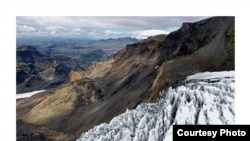Iceland is a small country, about one quarter larger than Ireland or about the size of the U.S. state of Ohio. It sits on the edge of the Arctic Circle in the North Atlantic. Most of its 300,000 people live in or around the capital, Reykjavik. But through the skilled eye of landscape photographer Feodor Pitcarin, Iceland appears like an isolated planet from another galaxy.
The raw beauty of this tiny windswept nation is the subject of a new photo exhibit. There are no people in the photographs in "Primordial Landscapes: Iceland Revealed" - just fire, ice, hardy life and natural wonders.
Pitcarin visited Iceland for the first time in 2011, and recalls he was immediately captivated by the stunning landscapes.
"Craggy ocean shorelines, volcanic mountains, hot springs, ice fields and so much more," he said. "With each return visit I became more intimately humbled by the power of nature.”
Timing is everything
Pitcarin says his secret to capturing that power with his camera is timing.
“On a typical day I will find perhaps, maybe half a dozen locations, where I think it is worth waiting for the right light, the right conditions, the sudden changes that happen with the clouds, the wind,” he said.
Iceland is a land of 30 active volcano systems. Pitcarin waited a year to shoot one erupting. He spent two weeks last August, poring over seismic maps and making and canceling reservations until the ground started to rumble. Pitcarin was soon in the air and on the ground as the lava flowed from Bardarbunga, the island’s largest volcano.
“It was such a primordial scene. There was a huge column of dust blowing across this vast open stretch," he said. "And in the background, you could see the linear fires of this volcano spewing out in a long, long rift.”
A land of stark beauty
Pitcarin's photos seem to capture the geologic changes that formed Iceland's landscape, says exhibit developer Jill Johnson at the Smithsonian National Museum of Natural History.
“You are seeing these processes in action and then you are watching as say a volcano erupts and then you have new ground," she said. "And, what starts to colonize? What takes over? What plants come in? You see a glacier as it is slowly melting, as it scrapes away, what landscape is revealed?”
Pitcarin says the images in "Primordial Landscapes" are more than beautiful pictures.
“I try to capture something that is evocative, something that resonates with the human spirit,” he said.
The photographs resonated with museum-goer Laima Lenge. She says the images have changed her idea of Iceland, a place she would like to visit someday.
“The extent to which the wilderness is presented here is just extraordinary," she said. "It inspires me to go back into my inner landscape and reconnect with nature.”
Arctic conservation
In April the United States began a two-year term as chair of the Arctic Council, a multinational forum that addresses issues faced by Arctic nations and native peoples of the region.
“What is happening in the Arctic has repercussions beyond our region,” said Gunnar Bragi Sveinsson, Iceland's foreign minister. “As caretakers of the Arctic, the eight Arctic states have a special role to play and a big responsibility.”
The Smithsonian National Museum of Natural History will play a role, as well. Museum director Kirk Johnson says, “We will be highlighting our Arctic connections with exhibitions like 'Primordial Landscapes: Iceland Revealed,' public programs and research symposia.”
The exhibit portrays a sense of wonder about Iceland and urgency to protect wild places everywhere.







